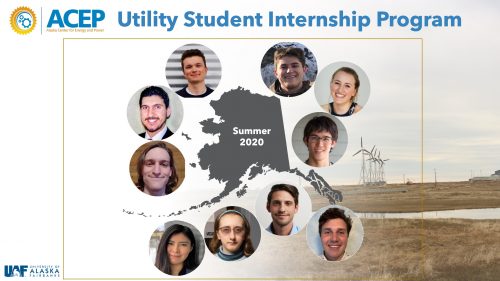Internships offer utility work experience
August 6, 2020
Ten students served internships on energy research projects for utilities and energy
entities across Alaska. The undergraduates were part of the Utility Student Internship
program, run by UAF's .
The purpose of the internships is to provide support for research needs of Alaska
utilities, and to develop the workforce required for the fast-changing energy sector
in Alaska, the United States and globally.
The internship program commenced in the spring semester with an Alaska Energy Utility
Lecture Series course and was followed up with a Microgrid Boot Camp, a preparatory
one-week intensive course focused on the resources, technologies and operations of
Alaska’s wide range of microgrid energy systems. After successful completion of the
boot camp, the students started their 12-week summer internships. The three parts
of the program were organized and conducted in collaboration with UAF Bristol Bay
Campus.
Ten students, mostly pursuing engineering and computer science degrees, were selected
for the second year of the internship program. Each intern is working with a different
utility or organization in various locations around Alaska, with work this summer
conducted remotely and virtually due to coronavirus restrictions. One intern spent
a week in Tok, Alaska, to provide engineering support for a pipe installation project.
Intern projects this summer:
— Performed a feasibility study for the integration of nuclear microreactors into
Copper Valley Electric Association's grid.
— Developed a heat transfer MATLAB script for measuring heat loss along the underground
piping systems for Doyon Utilities at Fort Wainwright U.S. Army post.
— Conducted a solar installation and battery storage feasibility study for Alaska
Power and Telephone’s site in Eagle, Alaska. Provided hands-on support for a project
at the power plant in Tok, created AutoCAD drawings for various sites, and conducted
vendor research for a project in Skagway, Alaska.
— Modeled a microgrid for Matanuska Electric Association in Talkeetna to provide
reliable power in support of existing radial feeders to remote areas of their grid.
— Developed and optimized the processing of photogrammetric data collected via unmanned
aerial systems into digital surface models for the permafrost tunnel site in Fairbanks
and coastal erosion sites in Southeast Alaska and the North Slope.
— Built data analysis tools and developed a thermal model for Taġiuġmiullu Nunamiullu
Housing Authority for analysis of heating and solar energy data for energy efficient
homes in Utqiaġvik, Alaska.
— Built a template for conducting energy profile surveys as part of the international
Community Appropriate Sustainable Energy Security partnership research initiative,
and completed a survey for the city of Galena, Alaska.
— Worked on a project to automate the power cost equalization program reporting process
for rural utilities in collaboration with 60Hertz Energy. Identified issues and processes
for using the 60Hertz software tool to automate the reporting process.
— Collaborated on the Eaton Project Data Management work by processing and visualizing
data collected at Eielson Air Force Base for detection, management and recovery from
transient events. Designed and developed several data management and visualization
tools and applications to process the collected data.
— Worked on the Golden Valley Electric Association carbon reduction study and investigated
how the utility can reduce their CO2 emissions by 26% in the next decade. Researched,
analyzed and modeled a number of technologies, including residential battery and electric
vehicle storage.
The internship is funded by a grant from the Office of Naval Research.
For more information on the AUSI program and the various projects, please contact
Heike Merkel at hmerkel@alaska.edu or Patty Eagan at pmeagan@alaska.edu, and visit .


